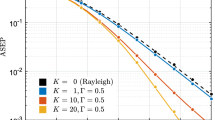Abstract
Bandwidth expanding signaling with quasi-orthogonal short codes is considered. The evaluation of the average probability of error analytically and by simulation is presented, for channels with multipath induced intersymbol interference (ISI) and for two different fading distributions. Namely Nakagami and Ricean fading distributions. The effect of intercell interference due to frequency reuse is also taken into account. Bit error rates (BER) for rake receiver with equal gain combining and postdetection integrator are presented. Both DBPSK and π/41 DQPSK modulations with noncoherent demodulation are analysed. The effect of TCM coding, in the expected BER is also evaluated.
Similar content being viewed by others
References
RACE R2067 MBS System Description Document, 1995.
G. Lovnes, “Channel sounding measurements at 59 GHz in city streets”, PIMRC'94, The Netherlands, Sept. 1994.
G. L. Turin, “Commutation signaling: an antimultipath technique”, IEEE Journal on Sel. Areas in Comm., Vol. SAC-2, pp. 548–562, July 1984.
U. Charash, “Reception through nakagami fading multipath channels with random delays”, IEEE Trans. on Comm., Vol. COM-27, pp. 657–670, Apr. 1979.
H. Xiang, Bynary code-division multiple-access systems operating in multipath fading, noisy channels-IEEE Trans. on Comm., Vol. COM-33, pp. 775–784, August 1985.
T. Eng and L. B. Milstein, “Comparision of hybrid FDMA/CDMA systems in frequency selective Rayleigh fading”, IEEE Journal on Sel. Areas in Comm., Vol. SAC-12, pp. 938–951, June 1994.
J. Wang and M. Moeneclaey, “Hybrid DS/SFH-SSMA with predetection diversity and coding for indoor radio”, IEEE Journal on Select. Areas Comm., Vol. 10, pp. 705–713, May 1992.
K. M. Cheung, H. Leib and S. Pasupathy, “Multipath induced ISI in bandwidth expanding signaling”, Proc. 16th Biennial Symposium on Communications, pp. 273–276, Queen's University, Kingston Canada, May 1992. Vol. 10, pp. 705–713, May 1992.
J. G. Proakis, Digital Communications, McGraw-Hill 1989.
E. Sousa, “CDMA Wireless Networks”, ICC'94 Tutorial.
A. Gusmao, “Performance evaluation of receiver adaptation procedures”, internal report MBS/WP2.2.2/IST083.1, July 1994.
A. Correia, “Spread-spectrum to combat multipath induced ISI”, Proc. PIMRC'95, Toronto Canada, pp. 517–521, Sept. 1995.
E. Biglieri, D. Divsalar, P. McLane and M. Simon, “Introduction to Trellis-coded modulation with applications”, Macmillan Pub. Co 1991.
D. Rhee and S. Rajpal, “Some block and Trelliscoded modulations for the Rayleigh fading channel”, Trans. on Comm., Vol. 44, pp. 34–42, Jan. 1996.
Author information
Authors and Affiliations
Rights and permissions
About this article
Cite this article
Correia, A.M.C. Commutation Signaling to Combat ISI over Nakagami and Ricean Fading. Wireless Personal Communications 7, 213–231 (1998). https://doi.org/10.1023/A:1008867627765
Issue Date:
DOI: https://doi.org/10.1023/A:1008867627765




